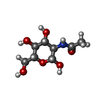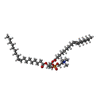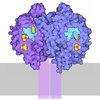[English] 日本語
 Yorodumi
Yorodumi- PDB-8zyj: Cryo-EM structure of human testis-specific Na+,K+-ATPase alpha4 i... -
+ Open data
Open data
- Basic information
Basic information
| Entry | Database: PDB / ID: 8zyj | ||||||
|---|---|---|---|---|---|---|---|
| Title | Cryo-EM structure of human testis-specific Na+,K+-ATPase alpha4 in ouabain-bound form | ||||||
 Components Components | (Sodium/potassium-transporting ATPase subunit ...) x 2 | ||||||
 Keywords Keywords | TRANSPORT PROTEIN / P-type ATPase / sodium pump / Na+ / K+-ATPase / testis / human | ||||||
| Function / homology |  Function and homology information Function and homology informationphotoreceptor cell cilium / protein transport into plasma membrane raft / Na+/K+-exchanging ATPase / positive regulation of sodium ion export across plasma membrane / positive regulation of potassium ion import across plasma membrane / membrane repolarization during cardiac muscle cell action potential / rod photoreceptor outer segment / P-type sodium:potassium-exchanging transporter activity / sodium:potassium-exchanging ATPase complex / membrane repolarization ...photoreceptor cell cilium / protein transport into plasma membrane raft / Na+/K+-exchanging ATPase / positive regulation of sodium ion export across plasma membrane / positive regulation of potassium ion import across plasma membrane / membrane repolarization during cardiac muscle cell action potential / rod photoreceptor outer segment / P-type sodium:potassium-exchanging transporter activity / sodium:potassium-exchanging ATPase complex / membrane repolarization / establishment or maintenance of transmembrane electrochemical gradient / cell communication by electrical coupling involved in cardiac conduction / sodium ion export across plasma membrane / flagellated sperm motility / ATPase-coupled monoatomic cation transmembrane transporter activity / intracellular sodium ion homeostasis / regulation of calcium ion transmembrane transport / fertilization / regulation of cellular pH / relaxation of cardiac muscle / regulation of cardiac muscle contraction by calcium ion signaling / Basigin interactions / sodium ion transport / organelle membrane / potassium ion import across plasma membrane / intracellular potassium ion homeostasis / ATPase activator activity / Ion transport by P-type ATPases / intercalated disc / lateral plasma membrane / sperm flagellum / transporter activator activity / transport across blood-brain barrier / ATP metabolic process / cardiac muscle contraction / Ion homeostasis / monoatomic ion transport / sperm midpiece / potassium ion transmembrane transport / T-tubule / sodium ion transmembrane transport / proton transmembrane transport / protein localization to plasma membrane / regulation of membrane potential / cell projection / establishment of localization in cell / sarcolemma / caveola / potassium ion transport / kinase binding / intracellular calcium ion homeostasis / MHC class II protein complex binding / extracellular vesicle / ATPase binding / regulation of gene expression / spermatogenesis / protein-macromolecule adaptor activity / basolateral plasma membrane / Potential therapeutics for SARS / response to hypoxia / cell surface receptor signaling pathway / cell adhesion / protein stabilization / apical plasma membrane / membrane raft / protein heterodimerization activity / innate immune response / protein kinase binding / ATP hydrolysis activity / extracellular exosome / ATP binding / metal ion binding / membrane / plasma membrane Similarity search - Function | ||||||
| Biological species |  Homo sapiens (human) Homo sapiens (human) | ||||||
| Method | ELECTRON MICROSCOPY / single particle reconstruction / cryo EM / Resolution: 2.37 Å | ||||||
 Authors Authors | Abe, K. / Blanco, G. | ||||||
| Funding support |  Japan, 1items Japan, 1items
| ||||||
 Citation Citation |  Journal: Int J Mol Sci / Year: 2024 Journal: Int J Mol Sci / Year: 2024Title: Molecular Structure of the Na,K-ATPase α4β1 Isoform in Its Ouabain-Bound Conformation. Authors: Kazuhiro Abe / Jeff McDermott / Hridya Valia Madapally / Parthiban Marimuthu / Chai C Gopalasingam / Christoph Gerle / Hideki Shigematsu / Himanshu Khandelia / Gustavo Blanco /      Abstract: Na,K-ATPase is the active ion transport system that maintains the electrochemical gradients for Na and K across the plasma membrane of most animal cells. Na,K-ATPase is constituted by the association ...Na,K-ATPase is the active ion transport system that maintains the electrochemical gradients for Na and K across the plasma membrane of most animal cells. Na,K-ATPase is constituted by the association of two major subunits, a catalytic α and a glycosylated β subunit, both of which exist as different isoforms (in mammals known as α1, α2, α3, α4, β1, β2 and β3). Na,K-ATPase α and β isoforms assemble in different combinations to produce various isozymes with tissue specific expression and distinct biochemical properties. Na,K-ATPase α4β1 is only found in male germ cells of the testis and is mainly expressed in the sperm flagellum, where it plays a critical role in sperm motility and male fertility. Here, we report the molecular structure of Na,K-ATPase α4β1 at 2.37 Å resolution in the ouabain-bound state and in the presence of beryllium fluoride. Overall, Na,K-ATPase α4 structure exhibits the basic major domains of a P-Type ATPase, resembling Na,K-ATPase α1, but has differences specific to its distinct sequence. Dissimilarities include the site where the inhibitor ouabain binds. Molecular simulations indicate that glycosphingolipids can bind to a putative glycosphingolipid binding site, which could potentially modulate Na,K-ATPase α4 activity. This is the first experimental evidence for the structure of Na,K-ATPase α4β1. These data provide a template that will aid in better understanding the function Na,K-ATPase α4β1 and will be important for the design and development of compounds that can modulate Na,K-ATPase α4 activity for the purpose of improving male fertility or to achieve male contraception. | ||||||
| History |
|
- Structure visualization
Structure visualization
| Structure viewer | Molecule:  Molmil Molmil Jmol/JSmol Jmol/JSmol |
|---|
- Downloads & links
Downloads & links
- Download
Download
| PDBx/mmCIF format |  8zyj.cif.gz 8zyj.cif.gz | 310.1 KB | Display |  PDBx/mmCIF format PDBx/mmCIF format |
|---|---|---|---|---|
| PDB format |  pdb8zyj.ent.gz pdb8zyj.ent.gz | 220 KB | Display |  PDB format PDB format |
| PDBx/mmJSON format |  8zyj.json.gz 8zyj.json.gz | Tree view |  PDBx/mmJSON format PDBx/mmJSON format | |
| Others |  Other downloads Other downloads |
-Validation report
| Summary document |  8zyj_validation.pdf.gz 8zyj_validation.pdf.gz | 1.7 MB | Display |  wwPDB validaton report wwPDB validaton report |
|---|---|---|---|---|
| Full document |  8zyj_full_validation.pdf.gz 8zyj_full_validation.pdf.gz | 1.7 MB | Display | |
| Data in XML |  8zyj_validation.xml.gz 8zyj_validation.xml.gz | 57.5 KB | Display | |
| Data in CIF |  8zyj_validation.cif.gz 8zyj_validation.cif.gz | 84.9 KB | Display | |
| Arichive directory |  https://data.pdbj.org/pub/pdb/validation_reports/zy/8zyj https://data.pdbj.org/pub/pdb/validation_reports/zy/8zyj ftp://data.pdbj.org/pub/pdb/validation_reports/zy/8zyj ftp://data.pdbj.org/pub/pdb/validation_reports/zy/8zyj | HTTPS FTP |
-Related structure data
| Related structure data |  60570MC M: map data used to model this data C: citing same article ( |
|---|---|
| Similar structure data | Similarity search - Function & homology  F&H Search F&H Search |
- Links
Links
- Assembly
Assembly
| Deposited unit | 
|
|---|---|
| 1 |
|
- Components
Components
-Sodium/potassium-transporting ATPase subunit ... , 2 types, 2 molecules AB
| #1: Protein | Mass: 108998.727 Da / Num. of mol.: 1 Source method: isolated from a genetically manipulated source Source: (gene. exp.)  Homo sapiens (human) / Gene: ATP1A4, ATP1AL2 / Production host: Homo sapiens (human) / Gene: ATP1A4, ATP1AL2 / Production host:  Homo sapiens (human) / References: UniProt: Q13733, Na+/K+-exchanging ATPase Homo sapiens (human) / References: UniProt: Q13733, Na+/K+-exchanging ATPase |
|---|---|
| #2: Protein | Mass: 35108.258 Da / Num. of mol.: 1 Source method: isolated from a genetically manipulated source Source: (gene. exp.)  Homo sapiens (human) / Gene: ATP1B1, ATP1B / Production host: Homo sapiens (human) / Gene: ATP1B1, ATP1B / Production host:  Homo sapiens (human) / References: UniProt: P05026 Homo sapiens (human) / References: UniProt: P05026 |
-Sugars , 1 types, 2 molecules 
| #9: Sugar |
|---|
-Non-polymers , 7 types, 310 molecules 












| #3: Chemical | ChemComp-MG / | ||||
|---|---|---|---|---|---|
| #4: Chemical | ChemComp-NA / | ||||
| #5: Chemical | ChemComp-CLR / | ||||
| #6: Chemical | ChemComp-OBN / | ||||
| #7: Chemical | | #8: Chemical | ChemComp-PCW / | #10: Water | ChemComp-HOH / | |
-Details
| Has ligand of interest | Y |
|---|---|
| Has protein modification | Y |
-Experimental details
-Experiment
| Experiment | Method: ELECTRON MICROSCOPY |
|---|---|
| EM experiment | Aggregation state: PARTICLE / 3D reconstruction method: single particle reconstruction |
- Sample preparation
Sample preparation
| Component | Name: alpha4-beta1 heterodimer / Type: COMPLEX / Entity ID: #1-#2 / Source: RECOMBINANT |
|---|---|
| Molecular weight | Value: 135 kDa/nm / Experimental value: YES |
| Source (natural) | Organism:  Homo sapiens (human) Homo sapiens (human) |
| Source (recombinant) | Organism:  Homo sapiens (human) Homo sapiens (human) |
| Buffer solution | pH: 6.5 |
| Specimen | Conc.: 10 mg/ml / Embedding applied: NO / Shadowing applied: NO / Staining applied: NO / Vitrification applied: YES |
| Vitrification | Cryogen name: ETHANE |
- Electron microscopy imaging
Electron microscopy imaging
| Microscopy | Model: JEOL CRYO ARM 300 |
|---|---|
| Electron gun | Electron source:  FIELD EMISSION GUN / Accelerating voltage: 300 kV / Illumination mode: FLOOD BEAM FIELD EMISSION GUN / Accelerating voltage: 300 kV / Illumination mode: FLOOD BEAM |
| Electron lens | Mode: BRIGHT FIELD / Nominal defocus max: 10000 nm / Nominal defocus min: 1000 nm |
| Image recording | Electron dose: 60 e/Å2 / Film or detector model: GATAN K3 (6k x 4k) |
- Processing
Processing
| CTF correction | Type: PHASE FLIPPING AND AMPLITUDE CORRECTION |
|---|---|
| 3D reconstruction | Resolution: 2.37 Å / Resolution method: FSC 0.143 CUT-OFF / Num. of particles: 162837 / Symmetry type: POINT |
| Refinement | Cross valid method: NONE |
 Movie
Movie Controller
Controller


 PDBj
PDBj


















